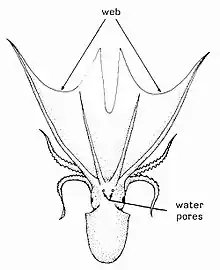Blanket octopus
Tremoctopus is a genus of pelagic cephalopods, containing four species that occupy surface to mid-waters in subtropical and tropical oceans.[2] They are commonly known as blanket octopodes, in reference to the long, transparent webs that connect the dorsal and dorsolateral arms of the adult females. The other arms are much shorter and lack webbing.
| Blanket octopus | |
|---|---|
 | |
| Adult female Tremoctopus | |
| Scientific classification | |
| Kingdom: | Animalia |
| Phylum: | Mollusca |
| Class: | Cephalopoda |
| Order: | Octopoda |
| Family: | Tremoctopodidae Tryon, 1879[1] |
| Genus: | Tremoctopus Chiaje, 1830[1] |
| Type species | |
| Tremoctopus violaceus delle Chiaje, 1830 | |
| Species | |
|
See text | |
| Synonyms | |
|
Philonexis d'Orbigny, 1835 | |
Tremoctopus violaceus exhibits the most extreme degree of sexual size-dimorphism known in any non-microscopic animal.[3][4] Females may reach 2 m (6.6 ft) in length, whereas the males are 2.4 cm. The weight ratio is at least 10,000:1, and can probably reach as much as 40,000:1. The males have a large arm in a spherical pouch modified for mating, known as a hectocotylus. During mating, this arm is detached, and kept by the female in her mantle cavity until used for fertilisation. The male almost certainly dies shortly after mating.[3] There is competition between the males, multiple male arms have been found in the mantle cavity of females.[3] The females carry more than 100,000 eggs attached to a sausage-shaped calcareous secretion held at the base of the dorsal arms and carried by the female until hatching.[5]
Blanket octopodes are immune to the venomous Portuguese man o' war, whose tentacles the male and immature females rip off and use for offensive and defensive purposes.[6] Like many other octopodes, the blanket octopus uses ink to intimidate potential predators.[7] Also, when threatened, the female unfurls her large net-like membranes that spread out and billow in the water, greatly increasing her apparent size.
Species
- Tremoctopus gelatus, gelatinous blanket octopus
- Tremoctopus robsoni
- Tremoctopus gracilis, palmate octopus
- Tremoctopus violaceus, common blanket octopus or violet blanket octopus
.jpg.webp)
.jpg.webp)
References
- Philippe Bouchet (2013). "Tremoctopus delle Chiaje, 1830". World Register of Marine Species. Flanders Marine Institute. Archived from the original on 21 January 2019. Retrieved 6 February 2018.
- "Tremoctopus". tolweb.org. Archived from the original on 17 September 2019. Retrieved 25 September 2019.
- Norman, M.D.; Paul, D.; Finn, J.; Tregenza, T. (2002). "First encounter with a live male blanket octopus: The world's most sexually size-dimorphic large animal". New Zealand Journal of Marine and Freshwater Research. 36 (4): 733–736. doi:10.1080/00288330.2002.9517126. Archived from the original on 19 January 2005.
- Pickrell, John (12 August 2003). ""Walnut-size" male octopus seen alive for first time". News. National Geographic Society. Archived from the original on 14 January 2005. Retrieved 12 February 2005.
- "Tremoctopus Eggs, etc". Tree of Life Web Project. Archived from the original on 16 September 2019. Retrieved 25 September 2019.
- Jones, E.C. (1963). "Tremoctopus violaceus uses Physalia tentacles as weapons". Science. 139 (3556): 764–766. Bibcode:1963Sci...139..764J. doi:10.1126/science.139.3556.764. PMID 17829125.
- Thomas, R.F. (1977). "Systematics, distribution, and biology of cephalopods of the genus Tremoctopus (Octopoda: Tremoctopodidae)". Bulletin of Marine Science. 27 (3): 353–392.
External links
 Data related to Tremoctopididae at Wikispecies
Data related to Tremoctopididae at Wikispecies Media related to Tremoctopus at Wikimedia Commons
Media related to Tremoctopus at Wikimedia Commons Tremoctopididae at Wikibooks
Tremoctopididae at Wikibooks- CephBase: Tremoctopus
- "Argonautoid families article – illustrates tentacle carrying". Tree of Life Web Project.